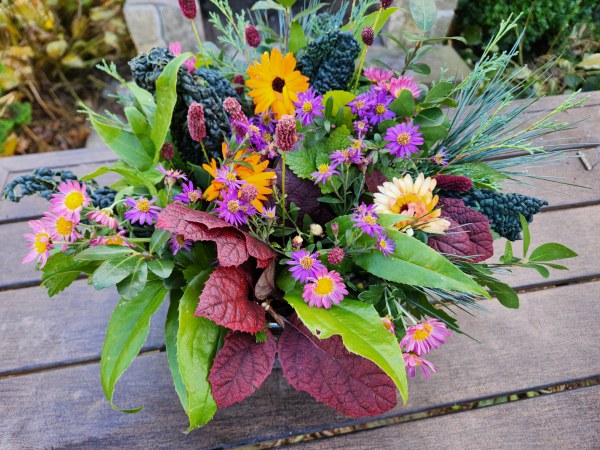
Sustainable Floristry
Nancy DuBruleShare

The topic of sustainable floristry has been swirling around in my mind for a while now. This holiday season, Natureworks has decided to take action to make our floral design work better for the planet. For the past few weeks, all of our designers have been experimenting with FibreFloral Design Media, a degradable brick made from all natural, volcanic basalt rock that has been spun into fibers (shown below). We tested it with evergreens and fresh flowers and have decided to offer it as a sustainable option to anyone who orders an arrangement from us this season. It is more expensive than a brick of traditional floral foam, but everyone I have talked to said they would be happy to pay a bit extra. It turns out that the green Oasis floral foam we have all used for decades not only doesn't biodegrade, it also contains microplastics.

It took me a little while to get used to working with this new material. It has a softer texture that Oasis. Stiff stems like evergreens and mums slide in easily. Softer stems need help by poking a hole with a stick. It slowed me down at first but then I got used to it. FibreFloral Design Media soaked up water really fast and held onto it well. Many days later, everything is hydrated and happy in my arrangement. I have to cut FibreFloral with a serrated knife. No problem there. I love the fact that when my arrrangement is done, the ENTIRE THING can be composted. The mineral-based foam will break down slowly, but it WILL break down.

Above you can see the arrangement I made using the FibreFoam. It contains Scotch pine, Green Giant arborvitae, white pine, Scotch broom, and Boulevard cypress evergreen foliage. I played around with herbs such as sage and even parsley flowers (I had to poke a hole for the parsley stems). Then I added flowers that were still blooming in my November garden- perennial mums, monkshood, and Aster 'Ezo Murasaki'. I included the deep burgundy red leaves of Itea (Virginia sweetspire) to add depth.

I have also been experimenting with other methods to make fresh arrangements without Oasis. Most are old fashioned and still work just great. For my entire career in horticulture I have been collecting forms, pin holders, and floral "frogs" made of glass along with vintage vases and containers. You can see one of my prize possessions, a very large, metal form that happened to fit perfectly in this beautiful blue bowl. I used it as a model and then took my father's tin snips and cut a piece of chicken wire, molding to fit the bowl.

With that done, I added water to the bowl and started arranging. Using this method I realized that anything goes when it comes to fresh material- the softness of the stem didn't matter. I began by adding foliage and then added flowers.

What fun I had! I used shiny green leaves of my Epimedium 'Domino'. I picked fresh kale and lemon balm, lots of perennial mums and asters, calendula blossoms, Sanguisorba (the elongated red flowers). I added Ilex crenata, boxwood, white pine, and native Chamaecyparis thyoides (Atlantic white cedar). The burgundy leaves are little branches from my oakleaf hydrangea which is a very deep burgundy red at this time of the year.
One thing I realized is that if you pick this arrangement up to move it, the water can easily splash out. So, when traveling with it, I would dump out excess water, pack it in a box with some towels, and be sure to refill the water when I arrive at my destination. Next time I would tape the chicken wire form down with thin, waterproof florists tape so it won't slip around..

Next I selected a footed glass container and found a glass floral arranger that I have had for years. They matched together perfectly.

I added water but only after I did so did I realize I should have secured the glass arranger with a piece of florist's clay. Next time I will. Florist's clay is sticky and totally waterproof and will keep the arrangement from moving around or falling out. Working with this form is a bit different as you have to stick the stems in the holes. But once I got the hang of it, I moved right along and it came out very pretty.

What I love about this method is that, in a clear glass container, all you see is the stems. If I had used Oasis, it would have stood out and looked strange.

This arrangement contains the dried seed heads of Sedum 'Autumn Joy', a mixture of my late blooming perennial mums, and some fresh cut evergreens. It is sitting on my dining room sideboard as I write this, many days later, looking as fresh as can be!

My last arrangement was made using a metal pin holder, also called a floral "frog". As you can imagine, I collect these too! I found a cute, burgundy red container that the pin holder fit into. Again, I should have secured it with floral clay. Then I made a simple arrangement of Japanese umbrella pine (Sciadopitys), white pine, Green Giant arborvitae, the red stems of blueberry and shrubby dogwoods, and culinary sage.

Adding water to this arrangement is so easy and I expect it to last for many weeks and fill my kitchen with seasonal beauty.
Sometimes the old ways are the best! AND, embracing new technologies and products manufactured with the health of our planet in mind gives me great hope for the future of sustainable floristry.
